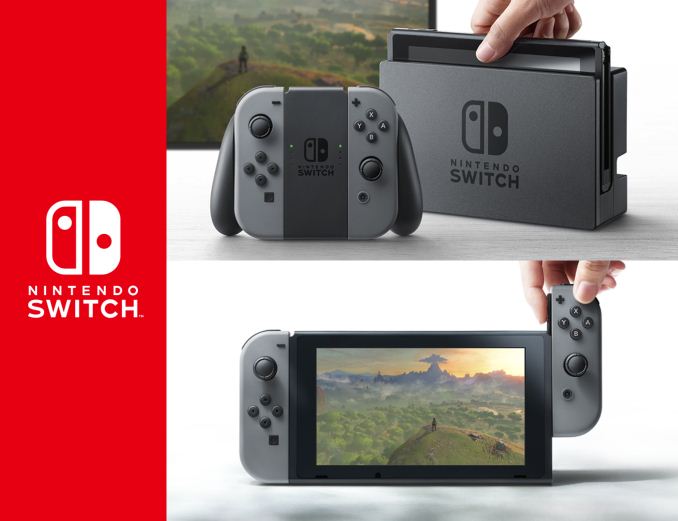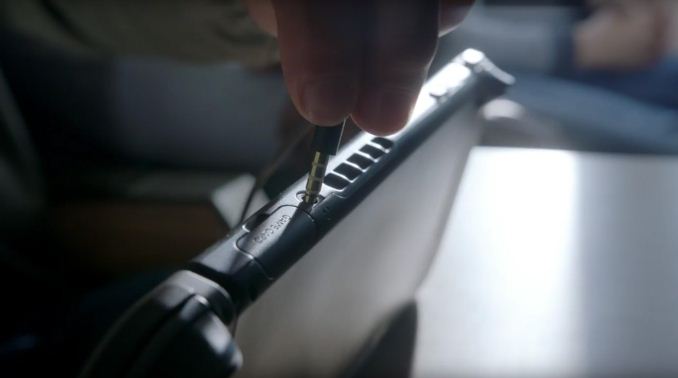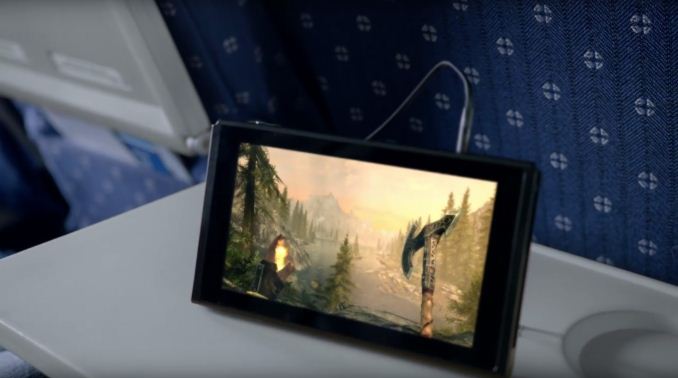Nintendo Announces Switch Portable Gaming Console - Powered by NVIDIA Tegra
by Ryan Smith on October 20, 2016 4:25 PM EST
Earlier today Nintendo took the wraps off of their next generation console, Switch. Formerly known by the codename NX, the Switch is the successor to both Nintendo’s portable DS and set top Wii console lines, utilizing a portable, tablet-like unit that can be docked to behave like a set top console. Today’s announcement, in the form of a 3 minute trailer, is meant to tease the console ahead of its full launch in March of 2017.
While I’ll skip the commentary on the console’s unusual design – dedicated gaming sites can offer better context – I wanted to dive into the hardware in the Switch. Given that this was a teaser, I was not expecting a reveal of any of the hardware specifications of the console, and indeed neither Nintendo’s teaser video nor their related press release made any mention of the underlying hardware. However shortly after the reveal went live, NVIDIA sent out an email to the press and posted a blog of their own. As it turns out, while today is still just a teaser, in some ways we’re already getting more information about the console than in any previous generation of Nintendo’s hardware.
In their blog post, NVIDIA confirmed that they would be providing the underlying SoC for the console. As this is still ultimately a teaser, NVIDIA’s own details are light, but their announcement confirms that it’s a custom version of their Tegra SoC. Curiously, no mention of the CPU core in that SoC is mentioned. However as it’s a Tegra, something ARM-based is the logical (if not only) choice. And on the GPU side, as you’d expect, they’re using a GPU based on one of NVIDIA’s existing GPU architectures, though the company isn’t specifying if it’s Pascal or Maxwell (I’d assume Pascal, but consoles are known for their long development cycles).
Otherwise, as far as specifications go that’s all we get for now. Though as NVIDIA is supplying a whole SoC there are obviously many more parts to the package that we’ll hopefully learn about in the near future. More CPU and GPU details are obviously the most interesting aspect – does the Switch SoC use Denver CPU cores? – but there’s also the matter of memory bandwidth, WiFi support, and the many other functional blocks that make up an SoC.
For NVIDIA, this is the first console hardware win for the company since the PlayStation 3, which launched in 2006. In the set top console market, AMD has since provided the GPU (and often, the CPU) for the most recent generation of consoles. Otherwise NVIDIA has never had a 3rd party portable console win, primarily because both Nintendo and Sony developed their respective SoCs internally for the 3DS and Vita.
In fact, given that Nintendo previously did much of their portable console development work internally, this is a notable shift for how the company operates. The 3DS was essentially a custom SoC combining multiple ARM11 (ARMv6) CPU cores with an OpenGL ES 1.1 generation GPU from the little-known Digital Media Professionals (DMP). So this is the first time Nintendo has contracted out their SoC needs to a third party in such a visible fashion. I’m actually a bit surprised that NVIDIA is even allowed to talk about their involvement at this point in time, given Nintendo’s historical focus on secrecy.
Though all of this also helps to underline just how big a jump in technology the Switch is from the 3DS. On the CPU side alone it’s reasonable to assume we’re looking at CPU design in the neighborhood of 4.x DMIPS/MHz, versus ARM11’s approximate 1.3 DIMPS/MHz rate, so IPC will have increased significantly, never mind an increase in frequency. Meanwhile on the GPU side, Nintendo is going from a GPU that didn’t even have a programmable GPU pipeline (i.e. shaders) to a fully modern GPU, essentially catching up on a decade of mobile GPU development in a single bound. Given that the console has to work as both the company’s portable and set top consoles, Nintendo has opted to use far more modern tech than their traditionally conservative designs.
Finally, without reading too much into a 5 paragraph announcement, there is one other interesting nugget of information in NVIDIA’s blog post that further shows just how deep the NVIDIA/Nintendo relationship is going here. Along with providing the SoC, NVIDIA also has a major stake in the development of the console’s API and middleware. While NVIDIA presumably isn’t developing the entire software stack, they make special note of the fact that they are providing a new “lightweight” API, NVN, for the console. NVIDIA is also providing middleware in the form of “a revamped physics engine, new libraries, advanced game tools and libraries” and “custom software for audio effects and rendering” which sounds a great deal like NVIDIA having brought over major parts of their GameWorks SDK, including the PhysX physics simulation libraries and VRWorks Audio library.
In any case, it will be interesting to see how this plays out over the next few months. The mobile world has changed significantly since the 3DS was launched in 2011, something that the Switch’s design makes obvious. Nintendo has gone in a very different direction than either their console rivals or the smartphone market that is always threatening to encroach on mobile consoles, and that’s reflected in both the unusual dual-mode console and the hardware inside of it.












109 Comments
View All Comments
nikon133 - Tuesday, October 25, 2016 - link
X2 with 2 power profiles, desktop and portable? Reduced res, reduced clock for portable... maybe some other measures... and games with 2 profiles, too. Basically low and high settings, with auto-switch depending on console mode.michael2k - Friday, October 21, 2016 - link
There is a 10W Parker configuration. If we assume the screen and such takes another 2W and a 23WHr battery then it will last 2 hours. If they can underclock it to 6W then it will last 3 hours. If it's 4W then 4 hours.LukeTim - Friday, October 21, 2016 - link
Maybe they can underclock to 4W when the device is undocked, since it only needs to drive 720p, and then when docked it clocks up to the full 10W?Wolfpup - Friday, October 21, 2016 - link
The idea of underclocking parts of it when undocked, and hitting 720p instead of aiming for 1080p sounds kinda plausible-ish?Honestly I'm surprised by how good the Wii U's gamepad screen looks, so I think 720p will be fine, if that's what it is. And anyway it's coming from like Sega Genesis resolution 3DS LOL
LukeTim - Friday, October 21, 2016 - link
Also, it's not going to be running at full capacity 100% of the time, so those times are worst case.LukeTim - Friday, October 21, 2016 - link
It does seem to be Pascal based. The NVIDIA blog implies as much: "an NVIDIA GPU based on the same architecture as the world’s top-performing GeForce gaming graphics cards."psychobriggsy - Friday, October 21, 2016 - link
What is the Tegra X2's TDP?Tegra X1 is a 15W TDP (10W actual) 500 GFLOPS design, built on 20nm. It is therefore reasonable to assume that X2, built on 16nm, likely doesn't increase TDP massively. Allegedly the dev kits are actively cooled X1s, so likely overclocked.
Indeed a 20W TDP for ~750 GFLOPS appears inline with the 1050 Ti's 75W TDP for 2.1 TFLOPS, once you factor in LPDDR4 instead of GDDR5.
And we're talking about a 6" fat (compared to iPad, etc) tablet with vents for cooling on top, and thus at least passive cooling, with plenty of room for battery.
My speculation is that the Switch uses something closer to X2 than X1. Nvidia say it's using the latest architecture themselves, strongly indicating Pascal. We just don't know the configuration that Nintendo have chosen, but it seems likely it's between 600 and 800 GFLOPS.
Communism - Thursday, October 20, 2016 - link
Finally, a Nintendo mobile console that is actually worth a damn.Looking forward to the next mainline Pokemon game for the console.
JoeyJoJo123 - Thursday, October 20, 2016 - link
It's too bad that mainline Pokemon games persist to be poor rehashes built on formulaic tropes, and that GameFreak refuses to really innovate the IP.As an RPG series, the storyline is poor and is always built on poor tropes. You just moved into the region, and even though you're 12 years old in the game (and are twice as old outside the game) you're somehow assumed to know nothing about Pokemon and are introduced into how to capture them. There's a new professor this region named after a type of tree. There's an "evil" association trying break the bonds between trainers and Pokemon (often by theft). You have a rival. You have childhood friend. There's meaningless drivel (which GameFreak calls a plot) that goes on between the starting town and by the time you defeat the region's champion.
The gameplay has been mostly the same since Ruby/Sapphire and the truly last major competitive addition was abilities being attached to Pokemon, and before that was allowing held items by Pokemon in Gold/Silver.
Whenever they do add new elements, like Pokemon Contests, Battle Frontier, Sinnoh Underground, Mega Evolution, and now Z-moves, they literally drop support for adding more of the same thing in the following generation. (And it's pretty disappointing that they're dropping support for new Mega Evolutions, as this really helped give older Pokemon (with lower total base stats) better viability to the power creep in total base stats from new Pokemon in newer generations. For example, Pokemon like Pidgeot and Beedrill and Slowbro were outclassed, but Mega Evolution really benefitted them, and there's plenty of other worse Pokemon out there, like Corsola, Dunsparce, etc.
Each new Pokemon generation is more disappointing than the last. Mechanically, the game is slightly refreshed, but ultimately 90% of the core gameplay is the exact same as before.
Communism - Thursday, October 20, 2016 - link
Most of that is due to the fact that every Nintento mobile console after the Game Boy were pure trash.With a boost up to a console that has faster CPU cores than the PS4 Pro (and likely Scorpio), The possibility of a more capable GPU than PS4, along with probably a 1080p screen, one would hope they will make a mainline Pokemon game that actually advances upon the original Red and Blue.